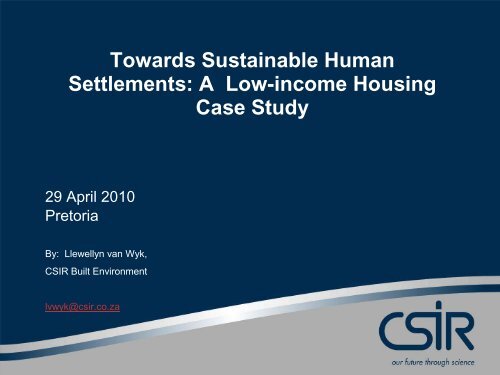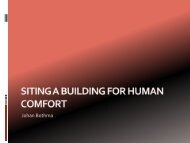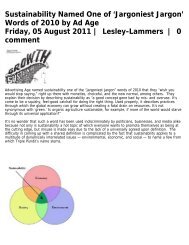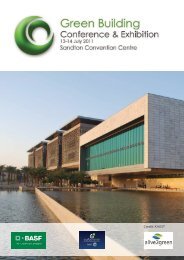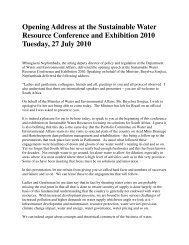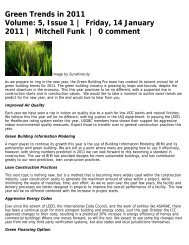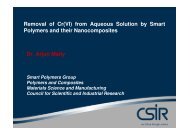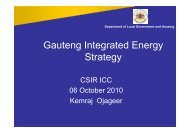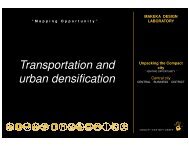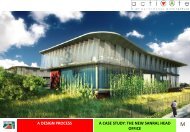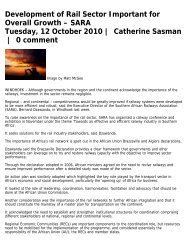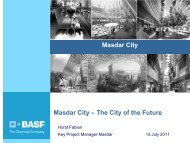Towards Sustainable Human Settlements: A Low ... - Alive2green
Towards Sustainable Human Settlements: A Low ... - Alive2green
Towards Sustainable Human Settlements: A Low ... - Alive2green
You also want an ePaper? Increase the reach of your titles
YUMPU automatically turns print PDFs into web optimized ePapers that Google loves.
<strong>Towards</strong> <strong>Sustainable</strong> <strong>Human</strong><br />
<strong>Settlements</strong>: A <strong>Low</strong>-income Housing<br />
Case Study<br />
29 April 2010<br />
Pretoria<br />
By: Llewellyn van Wyk,<br />
CSIR Built Environment<br />
lvwyk@csir.co.za
Background<br />
• Department of Science and Technology (DST) funding for CSIR<br />
research and development (R&D) in low-income housing arena in 2006<br />
• Objective: Use science, engineering and technology (SET) to support<br />
sustainable human settlements<br />
• Research question: How can innovative technologies be applied to<br />
existing low-income housing design and construction - at no or low<br />
extra costs - to improve building performance and sustainability<br />
• Research objective: Scientifically determine shortcomings of default 40<br />
m 2 low-income house and then integrate, apply and test appropriate<br />
innovative technologies to overcome those shortcomings<br />
• Desired outcome: Improved low-income housing performance – i.e.,<br />
more comfortable, durable, quicker to build, readily alterable, easily<br />
extendable, and less dependent on municipal services.
Context<br />
• 6,3 billion people<br />
• 73 million per year<br />
• Equivalent to a new<br />
Johannesburg/Pretoria every 2<br />
months<br />
• Growing inequalities between<br />
rich and poor<br />
• Lack of social cohesion<br />
• Infrastructure collapse<br />
• Ecological collapse<br />
• Social collapse<br />
• Challenge is about adaptation<br />
and mitigation
Context<br />
• Housing backlog 2.2 million units<br />
• 40% of households do not have refuse<br />
collected once a week<br />
• 14.5% of households live in informal dwellings<br />
• 20% of households do not use electricity for<br />
lighting<br />
• 42% of households do not use electricity for<br />
heating<br />
• 34% of households do not use electricity for<br />
cooking<br />
• 53% of households have no access to piped<br />
water inside the dwelling<br />
• 45% of households have no access to flush<br />
toilets connected to sewerage<br />
• 8% do not have access to any toilet facility
Current low quality, low-income housing<br />
Mdantsane (Buffalo City, Eastern Cape) & Kleinmond, (Western Cape)
Millennium Villages Project: Underlying Principles<br />
• Community empowerment through participation and<br />
leadership in design, implementation, monitoring and<br />
evaluation<br />
• Interventions based on proven, science-based research<br />
(biophysical and socioeconomic) combined with the best<br />
local knowledge<br />
• Implementing within the budget estimates<br />
• Building on existing community, government and nongovernment<br />
programs in the area<br />
• Building capacity and empowerment at the local level<br />
• Strengthening local institutions<br />
• Linking with and obtaining support from local, provincial<br />
and national governments<br />
• Consistency with national plans for interventions
Brundtland Report: 5 Key Concepts<br />
• Needs:<br />
• Essential needs of the world’s poor.<br />
• Limitations<br />
• Imposed by the state of technology and social organisation on the<br />
environment’s ability<br />
• Responsibility<br />
• The environment is held as a proxy for social equity between<br />
generations<br />
• Transformation<br />
• Sustainability is pro-development providing that it “involves a<br />
progressive transformation of economy and society<br />
• Ecological Capital<br />
• Impact of development on the quality of natural elements must be<br />
accounted for
Designing for Sustainability<br />
Design needs to shift from a paradigm of ‘transforming nature’<br />
to ‘transforming society’ towards sustainability by<br />
improving quality of, and relationships between, all living<br />
things, communities and the natural/built environment.<br />
Designers in all fields need to:<br />
• Re-examine human needs and set appropriate goals which<br />
prioritizes ecological sustainability and social equity;<br />
• Rethink the basic nature, methods, and goals of the design process<br />
itself;<br />
• Integrate knowledge from other fields concerned with human and<br />
ecosystems health; and<br />
• Promote new technologies, systems of production and construction<br />
methods that do not rely on natural capital, fossil fuels and harmful<br />
chemicals.<br />
J. Birkeland (2003), Design for Sustainability: A Sourcebook<br />
of Ecological Solutions
Experimental Work<br />
© CSIR 2006
Porous pavement<br />
Amphitheatre<br />
June 2008 – March 2009<br />
© CSIR 2006<br />
CRCP road
Conventional/fringe & hybrid technologies<br />
Suburban house<br />
RDP house<br />
CSIR house<br />
June 2008 – March 2009<br />
© CSIR 2006<br />
Expanded<br />
polystyrene<br />
Lightweight<br />
steel
Site Planning<br />
• Site planning<br />
• Mdantsane and Kleinmond<br />
site orientations<br />
• Conventionally houses<br />
positioned to face the street<br />
• Sitting room & main<br />
bedroom to street
Orientation<br />
• Optimum orientation<br />
facilitates improved<br />
thermal performance and<br />
comfort<br />
• Orientated for:<br />
• Protecting from sun in morning<br />
and afternoon<br />
• Maximising winter sun<br />
• Restricting southern exposure<br />
• Optimum positioning to<br />
ensure that:<br />
• The house is expandable<br />
• A car can be accommodated<br />
• There is a reasonable distance<br />
between adjoining houses<br />
• House can be developed into a<br />
fully-fledged three bedroom<br />
home over time
Innovative CSIR technology application<br />
Finishes<br />
Services<br />
Roof assembly<br />
Super-structure<br />
Sub-structure
Existing default house plan: Expensive expansion
CSIR house plan: Easy expansion
Sub-structure: Foundation quality improvement<br />
Default house foundations CSIR ultra-thin concrete house foundations
Sub-structure: Foundation quality improvement<br />
CRTCP excavations CSIR ultra-thin concrete house foundations
Super-structure: Design for modularity eliminates waste
Super-structure: Design for modularity eliminates waste
Super-structure: Conventional construction quality<br />
Mthinkhulu Village workshop<br />
Current Mdantsane houses
Super-structure: Improving workmanship through design<br />
Maintaining thickness of mortar joint<br />
CSIR house on left<br />
Default house above
Desired Quality
Super-structure: Exterior finish<br />
Default cementitious finish CSIR thermally-enhanced plaster
Roof assembly: Reinforced roof ring-beam reduces cracking<br />
U-beam forms ring beam
CSIR roof assembly: Roof operates as a gutter<br />
Changing direction of roof sheets to<br />
shade windows and work as a gutter<br />
Drip line indicates rainwater falling<br />
toward corner
Services: Prefabricated plumbing reduces risk and material use<br />
Installation<br />
quality<br />
Default house on<br />
left<br />
CSIR house<br />
Perception of quality<br />
CSIR house above<br />
Default house on left
CSIR technology transfer: Mdantsane (Buffalo City, Eastern Cape)
CSIR technology transfer: Mthimkhulu Village (Kleinmond, Western<br />
Cape)
CSIR technology transfer: Kleinmond, Western Cape
CSIR research outcomes and impact<br />
CSIR research outcomes and impact<br />
• Reduced use of concrete – estimate of 1 ton per<br />
house<br />
• Reduced CO 2 emissions – estimate of 1 ton per<br />
house<br />
• Reduced CO 2 emissions by PV lighting – 0.16<br />
kg/annum/house<br />
• Reduced CO 2 emissions by SWH – 3.613 kg<br />
per annum per house<br />
• Reduced material waste – modular construction,<br />
design-to-fit<br />
• Reduced construction time – no foundation<br />
walls, prefabricated plumbing<br />
• Improved energy efficiency – improved<br />
insulation, solar water heaters
CSIR research outcomes and impact (continued)<br />
• Improved water efficiency – rainwater harvesting,<br />
plugged shower base<br />
• Improved building quality – strength, finish<br />
• Improved thermal performance – orientation,<br />
thermal plaster, insulating ceiling, 43% less energy<br />
needed to heat and cool<br />
• Improved extendability – can be developed into<br />
fully-fledged three bedroom home without any<br />
demolition. Technology is familiar to beneficiary<br />
• If piloted and rolled out, CSIR technology could<br />
have major impact on low-income housing sector
Bulk services contribution in Kleinmond (411 units)<br />
• 1,027 kL/annum<br />
water saved<br />
• 1 299 993<br />
kWh/annum saved<br />
by SWH (1.299 tons<br />
CO 2/annum)<br />
• 65 760 kWh/annum<br />
saved through PV<br />
lighting (65.76 kg<br />
CO 2/annum)<br />
• 411 tons CO 2/annum<br />
saved on cement<br />
reduction
Way Forward
Conclusion<br />
• Green Building is now an established concept in property<br />
development and construction globally<br />
• South Africa is participating through the development of<br />
localised Green Star Rating Tools<br />
• The National Building Regulations and Standards Act is<br />
being amended to include environmental issues (Part X),<br />
commencing with Energy.<br />
• South Africa can, however, lead the way with regard to<br />
improving quality of, and relationships between, all living<br />
things, communities and the natural/built environment,<br />
even for the poorest of the poor.
Thank you<br />
The Team:<br />
Llewellyn van Wyk<br />
Prof. Andre de Villiers<br />
Luke Osburn<br />
Oom Adrian<br />
Oom Alex<br />
Coralie van Reenen


